Despite declining stock prices, only the Japanese, British and French indexes were down in November while previous gains were reduced elsewhere. Aside from the Topix which has been languishing for most of the year, the declines in the Nikkei, FTSE and CAC gave back a fraction of October's robust gains. The Bolsa followed by the Hang Seng and STI have registered over 20 percent gains in 2007.

Some of the stock declines were the result of the sinking dollar against every major currency. Other declines probably stemmed from a return of risk aversion, which has been notably lacking of late. While the falling dollar makes U.S. goods cheaper in international markets, it has the opposite effect on goods produced overseas. But the graph below shows that the dollar has been slowly declining in value for almost five years. The bars show the weighted average of the foreign exchange value of the U.S. dollar against a broad group of major trading partners while the line depicts a more limited group of currencies that circulate widely outside the country of issue. The latter would include such currencies as the pound sterling, euro and yen among others.

On the week, equity indexes were mixed, with the Japanese indexes registering the most impressive gains. However, indexes in Europe and the U.S. were down, while Canadian and Mexican stocks were up. Canadian stocks, which have fluctuated with energy prices, were up on the week, as were crude oil prices on the promise of cold weather in the U.S.
Global Stock Market Recap

Europe and the UK
European and British stocks managed to increase only one out of five days. Friday started off positively, but disappointing U.S. economic news sent the indexes south where they remained for the day and week. European stocks had the biggest weekly decline since July after manufacturing in the U.S. contracted for the first time in more than three years, sending the dollar lower and heightening concern that economic growth is slowing. Friday's ISM manufacturing report followed on the heels of an equally depressing Chicago Purchasing Managers' Index reading on Thursday. For the first time in more than three years, these indexes registered readings below the breakeven point of 50. In contrast, French and German PMI index readings improved while Spain and Italy did not. This resulted in a lower overall EMU index level but one that remained comfortably above 50.

The soaring values of the pound sterling and euro also weighed on stocks, especially those of exporters. The higher currency value makes their exports more expensive and less competitive. Countries such as Germany rely on trade for growth. For example, DaimlerChrysler AG and Tenaris led the decline by companies that rely the most on the U.S. for revenue as a weaker dollar will make their goods more expensive and cut the value of sales. The carmaker gets about 45 percent of its sales from the United States. Pearson Plc, owner of publisher Penguin Group Inc., sank because its North American division accounted for two-thirds of revenue last year. And Tenaris, a Luxembourg-based company that is the world's largest maker of seamless steel pipes, derived a quarter of its sales from North America in 2005.
Asia/Pacific
Asian/Pacific stocks were choppy last week. But the toll of the weakening dollar fell most heavily on the Hong Kong markets. Hong Kong's stocks suffered their worst one-day fall in percentage terms in six months on Tuesday as fears that the market's recent record-breaking rally might have been overdone were sparked by sharp overnight losses on Wall Street. The Hang Seng index plunged to 18.639.53, its lowest close since November 1st. The decline was the worst when measured in points for the index since September 12, 2001, the day after the terrorist attacks in the U.S. The decline followed a string of all-time highs for the index, culminating in a record closing peak of 19,265.32 on November 23rd. The market's recent strength has largely been attributed to optimism about China, particularly following the successful dual listing in Hong Kong and Shanghai last month of Industrial and Commercial Bank of China.

Currencies
Without a doubt, the focus in the last ten days has been on the currency markets and the U.S. dollar's slide. And troublesome economic news on Friday added to the currency's downward trajectory after manufacturing activity as measured by the Institute of Supply Management's manufacturing index contracted for the first time since April 2003. The dollar plunged as low as $1.9847 against sterling and $1.3348 against the euro in intraday trading. The euro's climb against the dollar and yen was supported by a continued run of favorable EMU data as well as stronger inflationary signals that have raised expectations of at least two more interest rate increases from the ECB.
Weak U.S. data only added fuel to the bearish factors. The scenario goes like this. The weak data have heightened expectations that the Federal Reserve will begin cutting U.S. interest rates. This in turn, has led to concerns that carry trades which had been supporting the dollar could be unwound. Meanwhile, the acceleration of dollar losses has amplified the chorus of central bankers talking about diversifying their reserves into other currencies, such as sterling and the euro.

The sharp dollar declines began last week (at the U.S. Thanksgiving break and in already thin markets) as some central banks, including the People's Bank of China, raised concerns that their huge currency reserves could be at risk from the weak U.S. currency. This reignited fears that the banks might be thinking about a major shift away from the dollar. Risk appetite declined, according to the Foreign Exchange Risk Index of investment bank UBS. This has suggested that some of the carry trade activity that had kept the dollar steady in recent months may be unwinding. Carry trades are where investors borrow in low-yielding currencies and invest in higher yielding assets.
Sterling traded at its highest level against the dollar in 14 years and since the currency's ejection from the European Exchange Rate Mechanism in September 1992. Recent volatility on foreign exchange markets has forced economic factors into the background as short-term investors made a series of assaults on key technical levels in sterling/dollar. Traditionally, the British currency performs well in December as UK companies repatriate dollar earnings ahead of the year-end. But that move has been exaggerated this year because of the severe pressure on the dollar against all major currencies since Thanksgiving.

Indicator scoreboard
EMU - M3 money supply for the three months ending in October was up 8.4 percent when compared with the same three months a year ago. For the month of October only, M3 was up 8.5 percent on the year. Money supply growth remains almost double that of the ECB's 4.5 percent target. Private sector loans expanded by 11.2 percent on the year, down slightly from September's 11.4 percent growth.

Third quarter gross domestic product was up 0.5 percent and 2.7 percent when compared with the same quarter a year ago. Growth was much weaker thanks primarily to no third quarter growth in France. On the quarter, third quarter private consumption was up 0.6 percent compared with 0.3 percent in the second quarter. However gross fixed capital formation was up 0.8 percent compared to second quarter's robust growth of 2.3 percent.

November flash estimate of the harmonized index of consumer prices was up 1.8 percent when compared with November of last year and up from October's increase of 1.6 percent. As with all flash releases, no detail is released.

October unemployment rate edged down to 7.7 percent from 7.8 percent in the previous month and the lowest since April 2001. The decline stemmed from the sharp drop in German unemployment, but unemployment was also down in France and Belgium. Eurostat uses a harmonized measure of unemployment and the national results can differ from these calculations even though they are calculated from the same raw data.

EU - November economic sentiment was virtually flat. Both industrial and consumer sentiment were flat at plus 5 and minus 8 respectively. Services, retail and construction were flat as well at 21, 4 and 3 respectively.

Germany - Third quarter gross domestic product was up 0.6 percent and 2.8 percent when compared with last year. Although all components contributed to growth, net exports contributed about two-thirds of the total. Domestic demand was up 0.2 percent, significantly less than the second quarter's increase of 1.1 percent on the quarter. The same pattern was followed by equipment investment. It was up 0.7 percent in contrast to the second quarter's gain of 3.1 percent.

October total retail sales were down 0.5 percent and up 0.6 percent when compared with last year. Excluding autos and gasoline stations, sales were down 0.2 percent and dropped 0.8 percent on the year.

November unemployment was down by 86,000 resulting in a drop in the unemployment rate to 10.2 percent from 10.4 percent in October. Most of the decline was in the West where the number of unemployed sank by 63,000 and brought the unemployment rate down to 8.5 percent, down from 8.7 percent in October. Unemployment in the East declined by 23,000. The unemployment rate dropped below the 17 percent mark to 16.7 percent.

France - Third quarter gross domestic product was unchanged and up 1.8 percent when compared with the same quarter a year ago. Downward pressure on third quarter growth came from the ongoing merchandise trade deficit along with slower inventory accumulation. The combination offset domestic demand. Private consumption was up 0.6 percent on the quarter while business investment was up by 0.8 percent. In contrast, second quarter private consumption was up 0.7 percent while business investment soared by 2.2 percent.
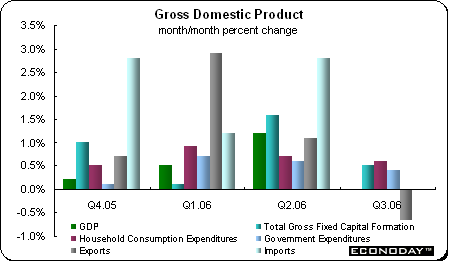
October unemployment rate remained at 8.8 percent for the second month. The number of unemployed was up by 5,000 according to the ILO definition which excludes jobseekers who did any work during the month.

Asia
Japan - October seasonally adjusted retail sales were down 0.2 percent but up 0.1 percent when compared with the same month a year ago. Sales of winter clothes and electronics led the decline. Clothing and accessories sales were down 3.3 percent on the year while electronics sales including flat-screen televisions, computers and mobile phones dropped 5.8 percent. The retail report doesn't capture spending on services or at Internet merchants. Sales on an unadjusted basis painted a somewhat different picture. They were up 2.2 percent and 0.1 percent on the year.
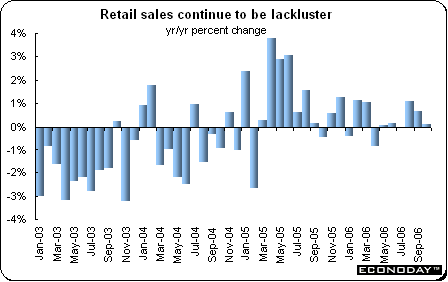
October industrial production jumped 1.6 percent and was up by 6.1 percent when compared with the same month a year ago. Gains were led by autos and semiconductors as production rose 7.4 percent from a year earlier, the biggest jump in more than two years. Transportation equipment, including cars, trucks, buses and auto parts, represents about 11 percent of total production in Japan.
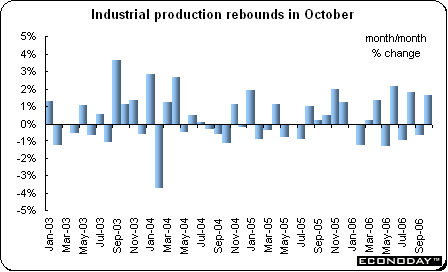
November Tokyo consumer price index was down 0.5 percent and up 0.2 percent when compared with last year. Core CPI excluding only fresh food was down 0.1 percent and up 0.2 percent on the year while the new core, which excludes energy as well as fresh food, was down 0.2 percent on the month and unchanged on the year. October national CPI was down 0.2 percent on the month and up 0.4 percent on the year. The core CPI, which excludes volatile fresh food but includes gasoline and heating oil costs, was unchanged on the month and edged up 0.1 percent on the year. The new core was up 0.1 percent but down 0.4 percent on the year.
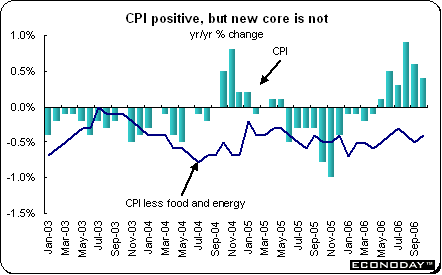
October unemployment rate edged down to 4.1 percent from 4.2 percent in September. The number of the employed was up by 280,000 from a year earlier to 64.37 million, up for the first time in two months. The ratio of job offers to job seekers at government placement offices declined to 1.06 in October from 1.08 in September (106 job offers for every 100 job seekers).
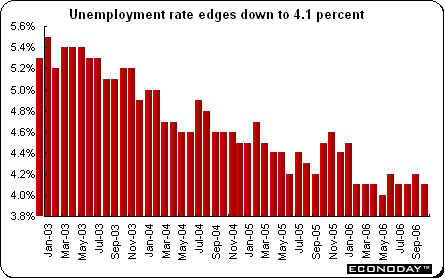
October household spending was down 2.4 percent when compared with last year. This was the 10th month that household spending declined. Spending on food, furniture, clothing and footware was down while home maintenance, healthcare and tuition spending increased.
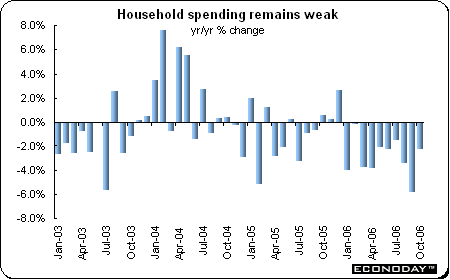
Australia - October merchandise trade deficit widened to A$1.3 billion from A$728 billion in September. Imports of machinery and consumer goods climbed, outpacing gains in mining exports. Australia's trade balance has been in deficit since April 2002, peaking at a shortfall of A$2.47 billion in November 2004. Total exports rose to A$18.05 billion in October. Farm exports, such as meat, sugar, wheat and wool, gained 0.4 percent. Shipments of non-rural goods, which include minerals, climbed 3 percent. Total imports rose to A$19.31 billion on the month. Imports of capital goods, which include business machinery and vehicles, were up 5 percent. Imports of intermediate goods, which include fuel, rose 6 percent. Imports of consumer goods gained 5 percent.
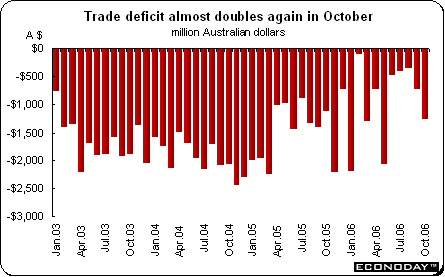
October retail sales were up 0.8 percent and 6.7 percent when compared with last year. Sales at department stores rose 4.3 percent in October from a month earlier. Spending on toys and cameras gained 4 percent and food sales climbed 1.2 percent.
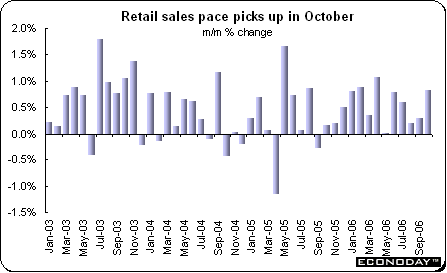
Americas
Canada - October industrial product price index edged down 0.1 percent and was up 1.2 percent when compared with last year. Lower prices for petroleum products in October were offset by higher prices for primary metal products and motor vehicles. On the year, upward pressure came mainly from higher prices for primary metal products and pulp and paper products.
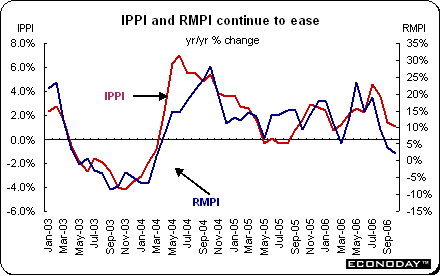
October raw materials price index was down 2.8 percent and was up 2.1 percent when compared with last year. The monthly decrease was due to mineral fuels, as prices for crude oil declined for a third consecutive month. On the other hand, non-ferrous metals and vegetable products registered significant price increases.
The Canadian dollar was down 1.1 percent against its U.S. counterpart in October. As a result, the total IPPI excluding the effect of the exchange would have fallen 0.4 percent instead of its actual decrease of 0.1 percent. On the year, the value of the Canadian dollar was up 4.3 percent against the U.S. dollar. If the impact of the exchange rate had been excluded, producer prices would have risen 2.3 percent between October 2005 and October 2006, rather than their actual increase of 1.2 percent.
Third quarter gross domestic product was up 0.4 percent and 2.5 percent when compared with the same quarter a year ago. Continued strength in business investment, non-residential structures and equipment, and a rebound in exports contributed to the quarter's growth. Exports were helped by sales of industrial goods and materials, machinery and equipment, agricultural and fish products, and other consumer goods. Consumer spending continued to contribute to growth.
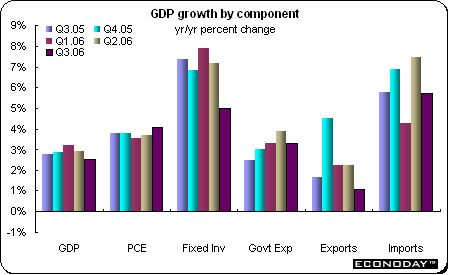
September monthly or industry gross domestic product was down 0.3 percent and was up 2 percent when compared with September 2005. The decline was primarily because of a mining strike in Labrador and the end of collection activities of the 2006 Census. Motor vehicle production was down sharply leading to a 1.4 percent decline in manufacturing.
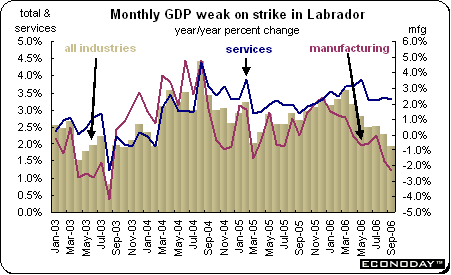
November employment increased by 22,400 jobs; however the unemployment rate inched up to 6.3 percent from 6.2 percent in the previous month. Full time employment was down by 18,100 jobs but part time employment jumped by 40,500 jobs. Private sector jobs increased by 50,000.
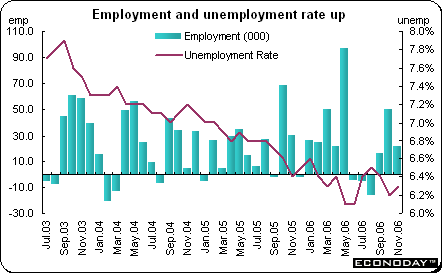
Bottom line
An avalanche of data enveloped investors last week. Overall, European data were the most positive with lower unemployment rates and brighter growth estimates. But Japanese data were mixed - unemployment declined but so did prices. Weak data did nothing to build confidence in the U.S. economy's prospects and how the Federal Reserve might react when it meets on December 12th. Economists remain split on the future for U.S. interest rates.
This week highlights the meetings of major central banks including the Banks of Canada and England, the Reserve Bank of Australia and the European Central Bank. Their current key interest rates are 4.25 percent, 5 percent, 6.25 percent and 3.25 percent respectively. Only the ECB is expected to increase their policy interest rate. Chancellor of the Exchequer Gordon Brown will deliver his pre-Budget report on Thursday. At that time, he is expected to increase his forecast for growth this year to about 2.6 percent.
Looking Ahead: December 4 through December 8, 2006

Anne D Picker is the author of International Indicators and Central Banks, which will be published by John Wiley and Sons in January 2007.

